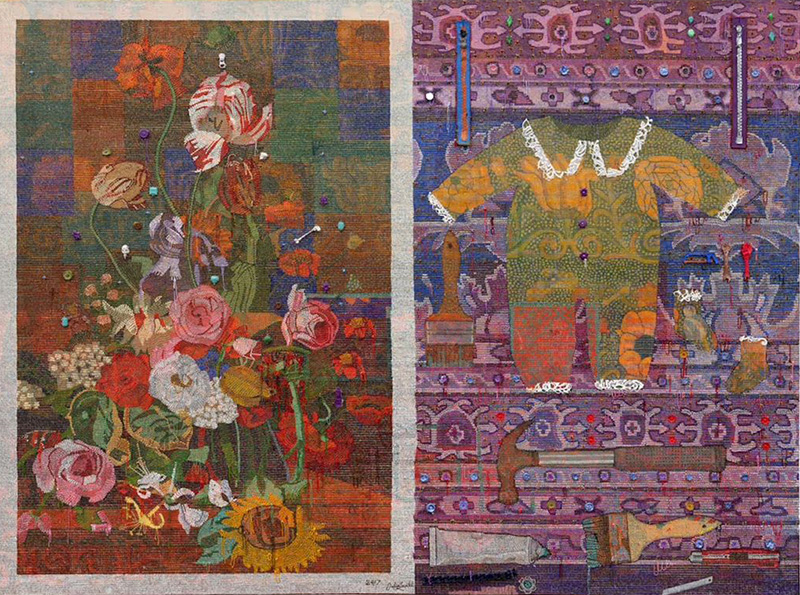
Talia Levitt, ‘50/50,’ 2025. Acrylic on canvas, 91.4 x 121.9 x 3.0 cm (36.0 x 48.0 x 1.2 in). Photo courtesy of the artist.
In her recent exhibition “24/7,” New York-based artist Talia Levitt offers a tender yet technically audacious meditation on the early months of motherhood. Conceived when the boundary between caregiving and studio life dissolved — “I was painting in bed with my daughter,” she has shared — this body of work reflects a life lived in overlapping rhythms of urgency, exhaustion, elation and tenderness.
Levitt’s works merge lullaby-soft domestic objects with art-historical rigor: pacifiers, baby clothes and childhood jewelry boxes appear alongside fruit, flowers and candles rendered in layered “trompe-l’oeil” and textile-like pattern. Through deeply considered material decisions — scored grids, piped paint mimicking embroidery, sequins and cast acrylic embellishments — she builds visual diaries that honor labor, intimacy and attention while expanding the language of contemporary still life.
A fourth-generation New Yorker, Levitt’s roots in the city are not incidental; they inform both her sensibility and research-based projects. In “Schmatta” (Uffner Liu, 2023), she examined the history of New York’s garment industry — a lineage she connects to through family history and a longstanding interest in textile traditions. Levitt received her BFA from the Rhode Island School of Design in 2011 and her MFA from CUNY Hunter College in 2019, and attended the Skowhegan School of Painting and Sculpture in 2019. Her grounding in drawing, paired with years immersed in New York’s contemporary art scene, shaped her evolving hybrid vocabulary of painting, craft, and illusion.
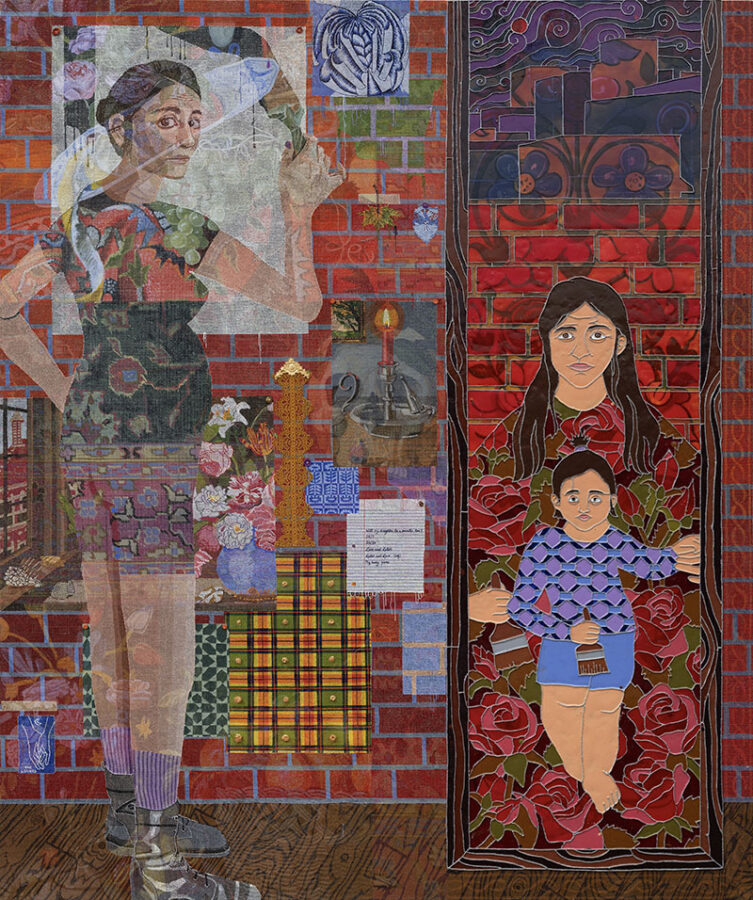
Talia Levitt, ‘Will My Daughter be a Painter Too?,’ 2025. Acrylic on canvas, 182.9 x 152.4 x 3.0 cm (72.0 x 60.0 x 1.2 in). Photo courtesy of the artist.
Levitt’s practice sits in dialogue with Dutch still life, feminist pattern-and-decoration movements, and craft histories, while posing contemporary questions about perception: “To force the viewer to ask themselves, is this honest or what is honest, is this real or what is real, what am I looking at, and how do I look at it?” she notes. “24/7” will next travel to the K11 Art Foundation in Shanghai, expanding the conversation to new audiences and contexts.
Visually lush, contemplative and narratively grounded, Levitt’s paintings locate harmony within layered chaos — where everyday objects glow with symbolic charge and domesticity becomes monumental. “Motherhood has changed the way I make and the way I see,” she reflects. “My daughter is my teacher.”
In a conversation with Global Voices, Levitt discussed the emotional and material shifts that motherhood sparked, the balance of rigor and play in her trompe-l’oeil technique, the democratizing history of still life, and how caregiving and studio life shape each other in real time.
Excerpts from the interview follow:

Talia Levitt, ‘Again!,’ 2025. Acrylic on canvas, 182.9 x 152.4 x 3.0 cm (72.0 x 60.0 x 1.2 in). Photo courtesy of the artist.
Omid Memarian (OM): For “24/7,” you emerged out of early motherhood, when studio and domestic life blurred. How do you think this profound experience permanently redefined your visual language?
Talia Levitt (TL): I can’t overstate how profoundly the merging of these worlds, or motherhood as the impetus, has changed the way I make and the way I see. My reference points in terms of imagery have shifted, for example. I have different experiences now to associate with a vast range of symbols. Therefore, changes are made to what is included in the paintings. I consider more deeply who my paintings would be legible to … now that I am watching my daughter learn how to look and discover. She is most drawn to photographic imagery, which serves as a gateway for her to explore illustration and other more abstract images in her books. I get to witness this development firsthand, and it has been truly inspiring.
Because I have created an expectation in my paintings that a variety of different languages will be employed, I can broaden my use of paint and range between realism and abstraction based upon what I’ve been learning through her.
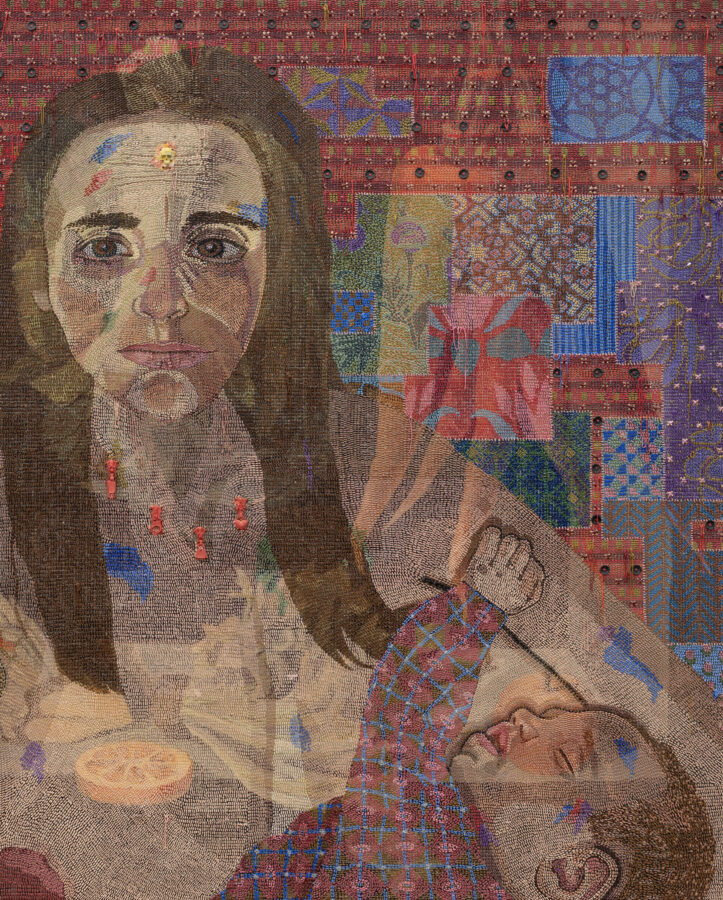
Talia Levitt, ‘My Body is a Mountain, My Body is Nourishment,’ 2025. Acrylic on canvas, 76.2 x 61.0 x 3.0 cm (30.0 x 24.0 x 1.2 in).
OM: Your interplay of trompe l’oeil illusion and symbolic motifs (Dutch still lifes vs. contemporary objects of childhood) dismantles hierarchies of the elevated and the everyday. Do you see this restructuring as situational or as a long-term reorientation in your practice?
TL: That’s a really interesting phrasing! I actually don’t think of one vs. the other, but rather the same genre and some similar content happening at two different time periods. Still life, even during the Golden Age of Dutch painting, was considered the lowest genre in the European academic hierarchy. Prints of and even original still-life paintings at the time were relatively affordable and accessible. This history has definitely emboldened me to bring a lot of muscle, academic skill, and some cheekiness to my work and to play with this history as well as to contemporarize motifs that were traditionally associated with trompe l’oeil.
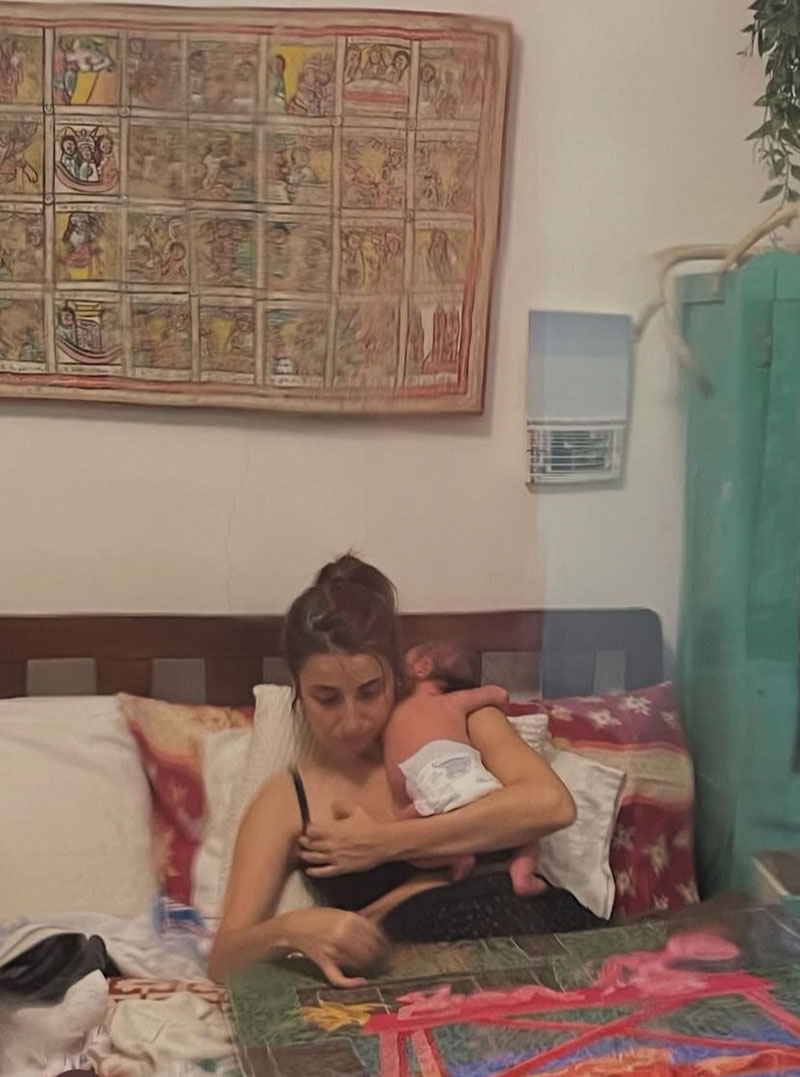
Artist Talia Levitt paints with her newborn resting on her shoulder — a glimpse into the intimate reality behind ‘24/7,’ the body of work shaped in the blur between caregiving and studio practice. Photo courtesy of the artist.
OM: Could you take us through your process step by step — from scored grids to cast acrylic embellishments? What were the breakthroughs that convinced you to make this hybrid of painting, craft, and illusion your primary method?
TL: In 2019, while on residency at Skowhegan [in Maine], I was attempting to paint the screen door of my barn studio. I thought, ‘There has to be a better way of realistically rendering this screen than to paint every tiny line of a grid.” So I took my ruler and a utility knife and began scraping it out of the painting of the door behind the screen. What I discovered was that I could use the paint or absence of paint to represent something extremely convincingly, while also creating the exact physical texture and behavior of the thing I was representing in reality. This opened up a door (pun intended!) to experimenting with and thinking about paint and trompe l’oeil as a genre in ways I had never considered before.
Step by step – first, imagery is painted directly onto the canvas with brushes. Then a grid is scored into the surface with a utility knife and ruler, and sealed with gloss medium. Then ‘stitching’ is piped out of sandwich bags, and lastly, the painting is embellished with casts, glitter, etc. It sounds very routinized, but there’s actually a lot of improvisation taking place within the described process.

Talia Levitt, ‘Emptied Out my Childhood Jewelry Box For Her and Found my Heart,’ 2025. Acrylic on canvas, 50.8 x 40.6 x 3.0 cm (20.0 x 16.0 x 1.2 in).
OM: Narratives seem central to your work, functioning as diaristic yet universal. How do you think narrative painting — often sidelined in modernist discourse — is reinvigorated in your work, especially in light of contemporary politics and social upheaval?
TL: I need to organize my response by narrative and use of paint. Narratively, I don’t think my experiences are unique, so hopefully, if I bring as much generosity and thoughtfulness to my work as possible, viewers may be able to connect with it. Perhaps this perspective reinvigorates narrative painting, or maybe it has been a strategy adopted by painters in some regard, with every progressive generation?
Materially, I am interested in using the properties of paint to disrupt direct interpretations. To force the viewer to ask themselves, is this honest or what is honest, is this real or what is real, what am I looking at, and how do I look at it? These questions are contemporary. While not necessarily political or social, they do explore themes that I know are both pertinent and universal.
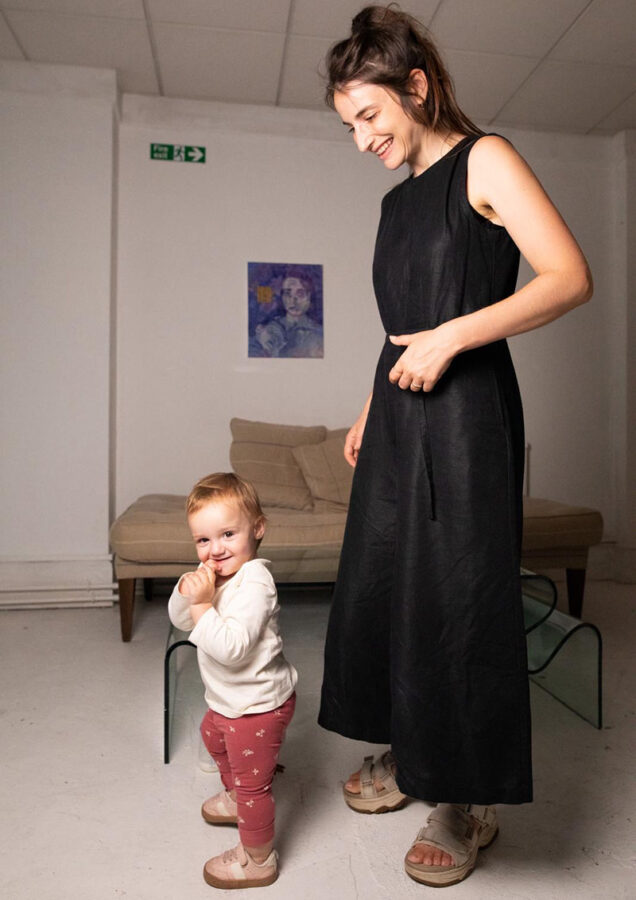
Talia Levitt and her daughter share a moment of play — a glimpse into the life that fuels her tender, intricate paintings and the world of ‘24/7.’ Photo courtesy of the artist.
OM: Because of what you said, your works invite close looking — the craft detail recalls textile traditions, yet the imagery resonates immediately. How do you think about accessibility in relation to art historical precedents like feminist pattern-and-decoration movements, Dutch still life, or even folk traditions?
TL: I definitely think about the accessibility of these traditions as a history to agitate in terms of craft’s relationship to Art History (capital A) and gender. This is an interest and motive that pairs conveniently with my fixation on and fascination with pattern and labor. I’ve always been attracted to craft, whether it be mosaic, stained glass, or embroidery, because of the extraordinary time involved in making the work, its beauty, history, and applications.
Learning about how mosaics are made, for instance, and traveling to see ancient examples of the craft employed in situ has motivated my interest in learning to mimic the craft with paint. Hopefully, this will continue to develop.

Talia Levitt, ‘Emptied Out My Childhood Jewelry Box For Her and Found my Heart,’ 2025. Acrylic on canvas, 50.8 x 40.6 x 3.0 cm (20.0 x 16.0 x 1.2 in). Photo courtesy of the artist.
OM: As both artist and parent, how do you navigate the lived realities of caregiving alongside studio practice? Do you see motherhood as a source of tension, of inspiration — or both?
TL: It has been a real blessing, but also quite challenging, balancing motherhood and painting.
My daughter has been an inspiration to my work in innumerable ways. She is my teacher, showing me how to see and think in a different way. I do feel a lot of guilt being away from her to paint, and that’s been tricky to navigate. I’ve often picked her up from daycare early because of this, and end up painting at night. She’s always at the forefront of my mind. Perhaps this will change over time as she ages. What I can say, though, is that while my production has admittedly decreased a bit, I think my most recent body of work, created for Victoria Miro Projects after her birth, is my strongest to date.

Talia Levitt, ‘All at Once,’ 2025. Acrylic on canvas, 50.8 x 40.6 x 3.0 cm (20.0 x 16.0 x 1.2 in). Photo courtesy of the artist.
OM: Your phrase “life lived all at once” captures both personal intensity and contemporary chaos. Looking ahead, do you envision continuing with diaristic motifs or moving toward broader social allegories?
TL: I love this question because it captures what's happening in the studio now — both! I'm best able to explore allegory through personal experience. ‘All at once’ actually came to me as I was trying to capture the democratic surface quality of my work, with the tirelessness of balancing home and studio —both themes in my recent show, ‘24/7.’








